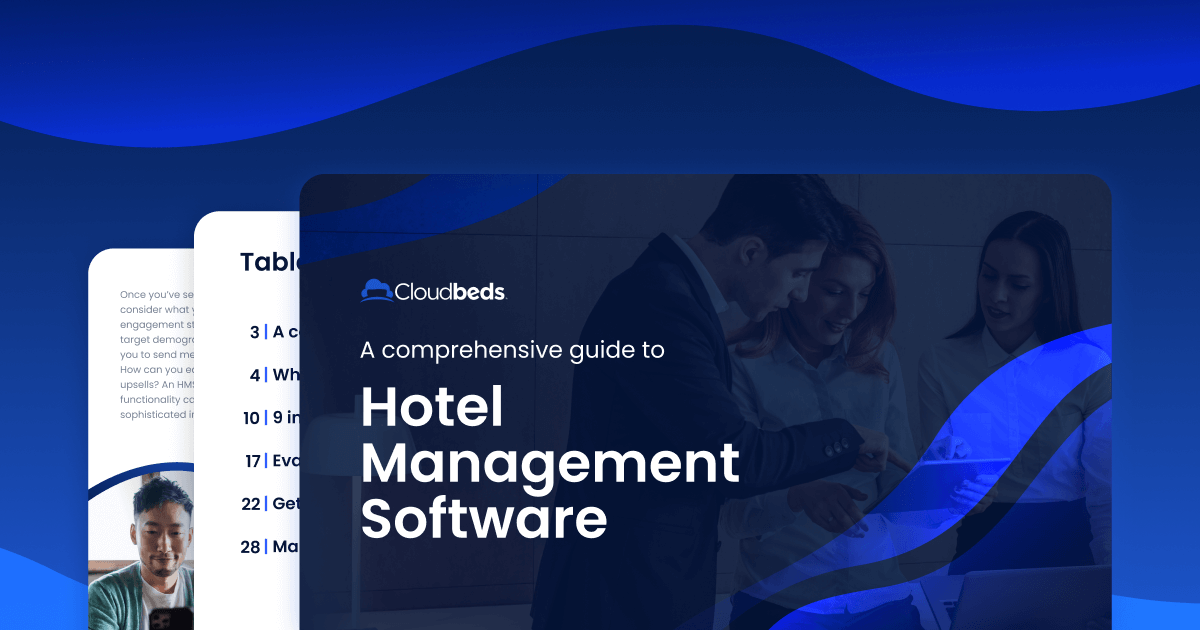
By Rafael Blanes
Nothing commands travelers’ attention quite like pricing. Fortunately, competitive pricing in the hospitality industry is much easier to participate in today thanks to rate shopping tools. It starts with identifying your competitive set, assessing your rates relative to your market, and then deciding where you want to be positioned. A rate shopping tool can take over from there, monitoring competitor activity for you and alerting you to rate changes so you can capture as many bookings as possible and maximize your revenue and profitability.
Here we’ll guide you through the steps of building a hotel compset and answer your questions along the way.
What is a hotel compset and why is it important?
A hotel competitive set (compset) is a group of hotels (about 3-5) that compete with a property most often for business because they attract the same type of guests. Identifying your compset is important because it helps you get a better understanding of what it takes to win over business from your competitors.
Here, Jacqueline Maloney, Product Marketing Manager at Cloudbeds, breaks down what a hotel compset is and how to define yours.
Think of it like interviewing for a job. If you know who the other candidates are and the skills they possess, you have a competitive advantage and can strategically position your own skills in a way that convinces the hiring manager to choose you.
Likewise, by familiarizing yourself with the hotels in your area that travel consumers most often consider alongside yours, you’ll have a clearer understanding of what it takes to convince travelers to choose you.
What is competitive hotel pricing?
Do you know how your competitors’ room rates compare with yours? If you’re not monitoring their rates, you’re at a distinct disadvantage. That’s because travel bookers certainly are paying attention, and it’s a safe bet your competitors are too.
In fact, pricing is second only to location when it comes to influencing booking decisions, according to recent data from STR. If travelers perceive your rates to be too high relative to comparable hotels, they will book elsewhere. If your rates are comparatively low, they will book up your hotel rooms first, and your competitors will get the higher-rated business. In either scenario, you’re losing revenue to competitors.
Competitive pricing doesn’t mean constantly undercutting your competitors’ rates. It’s about knowing your property’s value relative to that of your competitors, positioning your rates accordingly, and adjusting rates regularly in response to changes in market conditions and competitor activity. This is a tried-and-true revenue management strategy that will help ensure you don’t miss out on revenue opportunities.
What is rate shopping?
Rate shopping is a time-honored tradition in the lodging industry. Hotels would perform a daily call-around, phoning nearby hotels posing as a potential guest to inquire about rates and availability so they could benchmark their prices. More recently, hotels check their competitors’ rates online, using online travel agencies (OTAs) to ensure their own rates are positioned appropriately.
The challenge is that hotel compset pricing is extremely volatile today, especially post-pandemic, with rates changing regularly – sometimes several times a day. With a property to run and guests to take care of, who has time to keep track of compset rates manually?
That’s where a revenue management and rate shopping tool comes in. For example, Cloudbeds’ Pricing Intelligence Engine (PIE) will monitor competitor rates for you, displaying pricing data on an easy-to-use interactive dashboard so you can track your hotel’s performance and KPI metrics, including revenue per available room (RevPAR). This allows properties of all types and sizes to identify pricing trends, position your rates against competitors, and set parameters to adjust pricing in response to changes in market conditions.
How do you identify your hotel’s compset?
The first step to choosing your hotel compset is to identify 3-5 direct competitors. Maybe you feel your property is so unique you don’t have competitors? But even the most successful hotels have rivals for business. Or perhaps you think you have so many competitors it’s impossible to choose just five? Narrowing things down will help you stay focused and understand the difference between a competitive set and a non-competitive set. For example, a hotel that’s similar to yours in almost every category but is located on the other side of town may be a non-competitive set, depending on the size of the town.
To help get you started with your competitive set analysis, put yourself in the shoes of travelers. Think about the qualities they consider when deciding where to stay, paying special attention to a few key areas:
- Location. Properties closest to yours tend to be your biggest competitors because they share proximity to points of interest that attract travelers to your area. That may be activities or attractions, local businesses, or a sports and entertainment venue.
- Property amenities. Different types of travelers seek different types of amenities, whether they’re leisure or business travelers, families, couples, or groups. Your biggest rivals target the same segments as you with similar amenities such as a restaurant, bar, meeting space, swimming pool, and shuttle service.
- Room quality. Travelers also compare properties with similar room categories and bed configurations. Better quality room amenities will produce a higher perceived value of the property.
- Reviews. The review score for each property will be an additional deciding factor guests will consider when choosing their final accommodation. The ultimate decision-making tie-breaker between properties with a very similar location, amenities, and room quality can come down to guest reviews, which is why managing your property’s reputation is so important to the hotel business.
Travelers will weigh the qualities mentioned above for each property. If they don’t think your hotel offers comparable value, they will choose a property that does.
How do you use a revenue management system to track your hotel compset?
Using Cloudbeds Pricing Intelligence Engine (PIE) as an example, we’ll demonstrate how you can track your hotel compset and earn more revenue. In PIE, you can search the database by zip code or postal code to find the local competitors you’ve chosen for your compset. As you select each competitor, you will be asked to specify which OTA channel to shop rates on, such as Booking.com or Expedia.
PIE allows you to track up to three compsets containing up to five properties each. As a best practice, after you input your primary compset with your main competitors, you should also create a secondary compset with a higher tier level of properties and a third compset with lower-tier, just so you can keep an eye on those segments and get a well-rounded view of your local market segments.
You can also build compsets depending on different factors. For example, if your property is close to a stadium, other hotels near the stadium may be competitors during special events only. Or perhaps you operate a hotel with a brewery and wish to track rates for other brewery properties. You could then set up a primary compset, a stadium compset, and a brewery compset.
Once you’ve built your compsets in PIE, you can then set up rules and alerts to get notifications when their rates change. For more tips on pricing, check out our article, 3 easy hotel pricing strategies you can automate to maximize revenue. For a visual demonstration, see the video below.
How can you use a hotel rate shopper?
Once you’ve loaded your compset, you’re ready to compare pricing using PIE’s Rate Shopper tool. A rate shopper is a revenue management tool that pulls rate information from designated distribution channels and displays them on an interactive dashboard.
PIE’s Rate Shopper displays rate information visually, in a 90 Day Graph view and a 90 Day Calendar view, allowing you to compare your rates with competitors on any given day, for the upcoming week, or for the entire season. This will help you identify pricing trends and develop a long-term pricing strategy, as well as track your property’s performance. For example, if your local NHL team gets into the playoffs but you haven’t been following the sports news, a sudden increase in competitor rates will signal that you should increase your rates too.
Here are just a few of the additional features offered by PIE’s Rate Shopper (see the video bleow for a visual demonstration):
90 Day Graph View
- Display rates in graph format for all properties within your compset or aggregated high and low rates.
- View competitors ranked by highest prices or lowest prices or compare rates for a specific accommodation type.
- View rates for all competitors within your compset or drill down on an individual property.
- Click on any data point in the graph to view property and price details.
90 Day Calendar View
- View your daily rates and rankings relative to your compset in calendar format.
- See how busy you are on any given day with the daily overall occupancy percentage display.
- Click any date on the calendar to view the room type associated with each rate.
- Competitor prices are color-coded according to whether their rates are higher, lower, or the same as yours.
- An arrow indicates whether rates increased, decreased, or stayed the same since the last refresh. Data is refreshed every 24 hours.
- Dates with a Closed status indicate that the property is either not available, sold out, or has a stay restriction in place on that date.
Position your property’s pricing relative to competitors
Once you’ve explored your compset rates, you’ll have the knowledge you need to position your pricing using PIE’s Rate Manager tool. The Rate Manager lets you see the number of rooms you have available on a given day and the rate you’re currently selling the room for, or your average daily rate (ADR). It gives you a consolidated view of all the information you need to make smarter pricing decisions, including your occupancy, available room inventory, competitor rates, and rules that have been triggered.
Then you can create alerts to notify you about changes within your compset activity. Set up alerts to notify you if you are priced the highest or lowest in your competitive set or if a certain competitor makes changes to their strategy. You can then confirm or deny adjustments to your own rates.
For example, you can tell PIE to keep rates $10 (or 10%) lower than Competitor A and $10 (or 10%) higher than Competitor B. If these competitors change their rates, PIE will send you an alert to confirm the change manually. This will help ensure you’re always ideally priced for your market. When your revenue management system is integrated with your property management system, channel manager, and booking engine, as is the case with Cloudbeds and PIE, you can make real-time rate updates across all your channels, streamlining your hotel operations.
Hotel revenue management software tools accessible to any property type
Once a luxury affordable only to big groups of hotels or chains, revenue management tools are now accessible to hoteliers and lodging operators of all types and sizes, revolutionizing the hotel industry. With Cloudbed’s Pricing Intelligence Engine, you won’t be paying for a bunch of expendable bells and whistles you’ll never use. Instead, you’ll get an easy-to-use yield management tool integrated with your property management system that offers all the key features you need to keep your pricing competitive.












